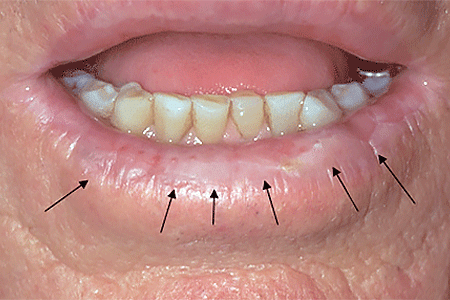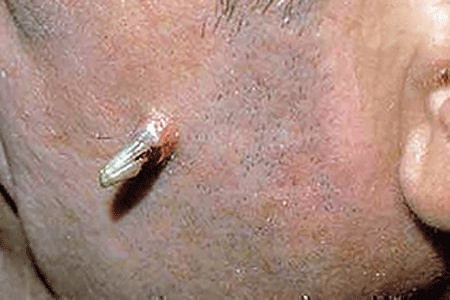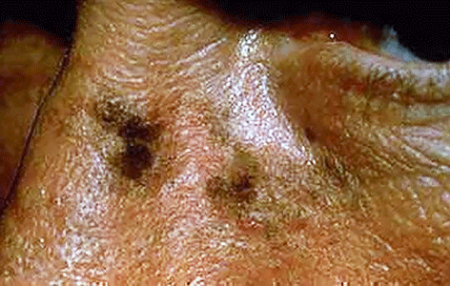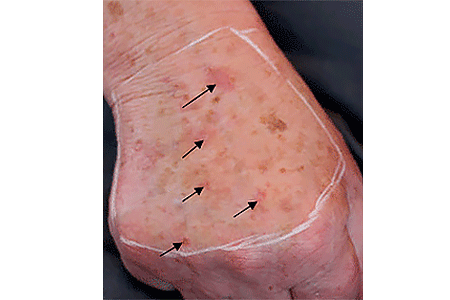

Hemangiomas/Angiomas are growths of blood vessels and other red spots which can be dilated blood vessels that take the form of a birthmark (Nevus Flameus).
Hemangiomas is a bright red birthmark that shows up at birth or in the first or second week of life. It looks like a rubbery bump and is made up of extra blood vessels in the skin. A hemangioma can occur anywhere on the body, but most commonly appears on the face, scalp, chest or back. It can grow out of proportion to the child for the first 8 months of life before the growth rate levels off. Therefore, it is important to evaluate these growths early especially if they are located around the eyes, mouth, genitals, scalp, neck or anus. Many hemangiomas disappear by age 5, and most are gone by age 10. The skin may be slightly discolored or raised after the hemangioma goes away.
Red bumps that we acquire with age or genetics are referred to as cherry angiomas. They often arise later in life and while not dangerous, can be considered unsightly. Their treatment can be simple and often requires no wound care enabling one to return to daily activities immediately.
A doctor can usually diagnose a hemangioma just by looking at it. Tests usually aren't needed.
A hemangioma is made up of extra blood vessels that group together into a dense clump. What causes the vessels to clump isn't known.
Hemangiomas occur more often in babies who are female, white and born prematurely.
Occasionally, a hemangioma can break down and develop a sore. This can lead to pain, bleeding, scarring or infection. Depending on where the hemangioma is situated, it may interfere with your child's vision, breathing, hearing or elimination, but this is rare.
Treating hemangiomas usually isn't necessary because they go away on their own with time. But if a hemangioma affects vision or causes other problems, treatments include medications or laser surgery:
If you're considering treatment for your child's hemangioma, weigh the pros and cons with your child's doctor. Consider that most infantile hemangiomas disappear on their own during childhood and that treatments have potential side effects.
Genital warts affect the moist tissues of the genital area. They can look like small, flesh-colored and be flat or bumpy or have a cauliflower-like appearance. Some genital warts are so small they cannot be seen. They can cause pain, discomfort or itching. Genital warts, also known as venereal warts, or condylomata acuminata, are caused by the human papilloma virus (HPV). More than 100 types of HPV are known to exist. Low risk types (HPV 1, 2, and 3) cause warts on the hands, feet, and other parts of the body. The low risk strains - Types (6 and 11) can cause warts on the genitals or anus (genital warts), and other high risk strains - Types (HPV 16 and 18) can cause cancer of the cervix, external genitalia, vulva, and anus.
Genital warts are sexually transmitted disease (STD) and all partners should be checked thoroughly. They can also be seen in infants who have been delivered vaginally to mothers with HPV in their genital tracts; therefore, alternate methods of delivery should be considered.
Only a small percentage of people infected with HPV will develop genital warts. Many people are carriers of HPV who may never develop warts, but may still be able to pass HPV to their sexual partners. The incubation period from contracting HPV until the development of warts may be several months although some people may not develop warts for years after contact with HPV. People who have lower immunity due to cancer, AIDS, organ transplantation, immune suppressive medications, or certain other medications are more susceptible.
To diagnose this condition, your doctor will do the following:
Although HPV isn't curable in all cases, genital warts are treatable. You can also go extended periods of time without an outbreak, but it may not be possible to get rid of the warts forever. That's because genital warts are only a symptom of HPV, which may become a chronic, lifelong infection for some.
If you've developed genital warts, your doctor has a few options for treatment. The fastest way to remove them is through surgery or to freeze them off with liquid nitrogen. Some doctors might use an electric current or laser treatment to burn off the warts.
Genital warts can go away with treatment from your healthcare provider or with prescription medicine. If left untreated, genital warts may go away, stay the same, or grow in size or number. Cervical precancer treatment is available.
Your doctor may apply a mild acidic solution, called an acetowhite test, to your skin to help make genital warts more visible. It may cause a slight burning sensation.
If you have a vulva, your doctor may also need to perform a pelvic examination, because genital warts can occur deep inside your body.
While visible genital warts often go away with time, HPV itself can linger in your skin cells. This means you may have several outbreaks over the course of your life.
So managing symptoms is important because you want to avoid transmitting the virus to others. That said, genital warts can be passed on to others even when there are no visible warts or other symptoms.
You may wish to treat genital warts to relieve painful symptoms or to minimize their appearance. However, you can’t treat genital warts with over-the-counter (OTC) wart removers or treatments.
Your doctor may prescribe topical wart treatments that might include:
If visible warts don’t go away with time, you may need minor surgery to remove them. Your doctor can also remove warts through these procedures:
To help prevent genital warts, HPV vaccines, condoms, and other barrier methods are available:
If you think you have genital warts, talk with your doctor. They can determine if you have warts and what your best treatment options are.
In addition, it’s important to talk with your sexual partner. This may sound difficult, but being open about your condition can help you protect your partner from also getting an HPV infection and genital warts.
Genital warts are a complication of a low risk HPV infection that’s common and treatable. They can disappear over time, but treatment is essential in preventing their return and possible complications.
Laser treatment can be utilized for small facial areas or for the entire face. Recently, full face treatments have become increasingly popular. Many people suffer from larger broken capillaries on their nose and cheeks and will have medium and smaller vessels on other facial areas. A full-face treatment will improve the overall facial appearance by creating a more uniform skin color, and by smoothing the texture of the skin.
Light emitted from the handpiece safely passes through the outermost layers of skin in search of the targeted vascular or pigmented lesions. Without damaging the surrounding skin, the laser?s intense light is absorbed by the targeted lesion. The light energy is then converted to heat and this initiates the process of eliminating the lesion. The treated lesion will gradually fade or diminish. In many cases, smaller vessels or pigmentation spots are eliminated in 2 to 4 treatments. Medium or larger vessels may take additional treatments.
The hand piece quickly advances across the skin delivering pulses to the treatment site. A full-face treatment typically lasts anywhere from 20 to 40 minutes. Smaller areas, such as the nose, can be treated in 15 minutes. In some cases a topical anesthetic cream is first applied to numb the treatment area. For a short period of time following treatment, a cold compress may be applied to soothe the possible appearance of slight swelling or redness of the skin. Treatments on the face, chest, neck, hands, legs, and abdomen are all done safely and quickly with laser technology.
During your consultation, your skin's condition will be evaluated and a customized treatment program will be suggested. In some cases only one or two treatments are required. However, in many cases three to five or more treatments will be required to achieve premium results. The number of treatment sessions will depend on the type of lesion to be treated, the location of the lesion on teh body, and its size and color. In many cases, it is recommended that treatments applied to the face be repeated at 3 to 4 week intervalas. The time intervals of your treatments will be determined during the consultation, where many of these issues and concerns may be addressed.
Age spots are small, flat dark areas on the skin. They vary in size and usually appear on areas exposed to the sun, such as the face, hands, shoulders and arms. Age spots are also called sunspots, liver spots and solar lentigines.
Age spots can look like cancerous growths. True age spots don't need treatment, but they are a sign the skin has received a lot of sun exposure and are an attempt by your skin to protect itself from more sun damage. You can help prevent age spots by regularly using sunscreen and avoiding the sun.
Age spots may affect people of all skin types, but they're more common in adults with light skin. Unlike freckles, which are common in children and fade with no sun exposure, age spots don't fade.
Age spots:
Age spots don't require medical care. Have your doctor look at spots that are black or have changed in appearance. These changes can be signs of melanoma, a serious form of skin cancer.
It's best to have any new skin changes evaluated by a doctor, especially if a spot:
Age spots are caused by overactive pigment cells. Ultraviolet (UV) light speeds up the production of melanin, a natural pigment that gives skin its color. On skin that has had years of sun exposure, age spots appear when melanin becomes clumped or is produced in high concentrations.
Use of commercial tanning lamps and beds also can cause age spots.
To help avoid age spots and new spots after treatment, follow these tips for limiting your sun exposure:
If you are tired of looking older or want the spots removed, schedule a laser consultation and restore your skin to its natural beauty. Our Cosmetic Consultation Reimbursement policy is offered to all patients. Schedule an office visit to discuss your concerns and skincare goals with Dr. Robinson and the office visit cost will be applied to the future cost for the "consulted procedure". The "consulted procedure" must be completed within 30 days of your consult visit.
Birthmarks are abnormalities of the skin that are present when a baby is born.
A birthmark can be red or brown.
A red or vascular birthmark is made up of dilated blood vessels. Two types are hemangiomas and port-wine stains. Although they can resolve spontaneously on their own, some can cause deformities and become more purple in color. With the advent of laser treatment, the Nevus Flameus can be cleared and subsequent deformities prevented.
A Nevus of Ota, Nevus of Ito and Mongolian spot are brown to bluish birthmarks that usually occur around the eye, shoulder and trunk respectively. Given their size and location patients often consider them cosmetically unacceptable, using the Medlite Nd:Yag laser these birthmarks can be treated effectively with excellent results.
An actinic keratosis, is a rough, scaly patch on the skin that develops from years of sun exposure. It's often found on the face, lips, ears, forearms, scalp, neck or back of the hands. These represent pre-cancerous growths that can become skin cancer if left untreated.
If you find a spot or growth on your skin that you think could be an actinic keratosis (AK), it’s time for a thorough skin exam. Should you have an AK, an accurate diagnosis and treatment can:
Most people who have AKs (or think they may have an AK) see a dermatologist. This is actually one of the most common conditions that dermatologists diagnose and treat.
When you see a board-certified dermatologist about AKs, your dermatologist will:
If you have one or more AKs on your skin, a board-certified dermatologist can often diagnose you by looking carefully at your skin. While examining your skin, your dermatologist will also look for signs of skin cancer. People who have skin that’s been badly damaged by ultraviolet (UV) light develop AKs and have a higher risk of getting skin cancer.
If you have one or more AKs, your dermatologist will talk with you about whether to treat these precancerous skin growths. Usually, treatment is recommended.
For a few people, a dermatologist may recommend frequent skin exams rather than treatment. Skin exams are recommended for patients who are frail and may find it hard to tolerate treatment. To be effective, treatment must destroy the AKs. When this happens, your skin will feel raw. It may be red and swollen for a brief time.
The treatment that is right for you depends on several considerations, including:
If you have one or a few AKs, a procedure that your dermatologist can perform during an appointment may be the preferred treatment.
You can often complete treatment in 1 or 2 office visits. The procedures that dermatologists use to treat AKs include:
Some people develop a few AKs, which can often be cleared with treatment.
If you have many AKs, it’s a good idea to be under a dermatologist’s care. Your skin has been severely damaged by UV light, so it’s likely you’ll continue get new AKs. You may also develop skin cancer. Your dermatologist can watch for signs of new AKs and skin cancer. When found early and treated, skin cancer is highly treatable.
Your dermatologist will tell you how often to return for check-ups. Some people need a check-up once or twice a year. If you have a weakened immune system or a rare condition that greatly increases your risk of developing AKs and skin cancer, you may need to see your dermatologist every 8 to 12 weeks.
Keep every appointment. If skin cancer develops, the sooner it is found and treated, the better your outcome.
Self-care also plays a key role in your outcome. The right self-care can help to prevent new AKs and skin cancer.







Acne is a skin condition which has plugged pores (blackheads and whiteheads), inflamed pimples (pustules), and deeper lumps (nodules). Acne occurs on the face, as well as the neck, chest, back, shoulders, and upper arms. Although most teenagers get some form of acne, adults in their 20's, 30's, 40's, or even older, can develop acne. Often, acne clears up after several years, even without treatment. Acne can be disfiguring and upsetting to the patient. Untreated acne can leave permanent scars; these may be treated by your dermatologist in the future. To avoid acne scarring, treating acne is important.
Acne is not caused by dirt. Testosterone, a hormone which is present in both males and females, increases during adolescence (puberty). It stimulates the sebaceous glands of the skin to enlarge, produce oil, and plug the pores. Whiteheads (closed comedones), blackheads (open comedones), and pimples (pustules) are present in teenage acne.
Early acne occurs before the first period and is called prepubertal acne. When acne is severe and forms deep "pus-filled" lumps, it is called cystic acne. This may be more common in males. Adult acne develops later in life and may be related to hormones, childbirth, menopause, or stopping the pill. Adult women may be treated at the period and at ovulation when acne is especially severe, or throughout the entire cycle. Adult acne is not rosacea, a disease in which blackheads and whiteheads do not occur.
Acne has nothing to do with not washing your face. However, it is best to wash your face with a mild cleanser and warm water daily. Washing too often or too vigorously may actually make your acne worse.
Acne is not caused by foods. However, if certain foods seem to make your acne worse, try to avoid them.
Wear as little cosmetics as possible. Oil-free, water-based moisturizers and make-up should be used. Choose products that are "non-comedogenic" (should not cause whiteheads or blackheads) or "non-acnegenic" (should not cause acne). Remove your cosmetics every night with mild soap or gentle cleanser and water.
A flesh-tinted acne lotion containing acne medications can safely hide blemishes. Loose powder in combination with an oil-free foundation is also good for cover-up.
Shield your face when applying sprays and gels on your hair.
Control of acne is an ongoing process. All acne treatments work by preventing new acne breakouts. Existing blemishes must heal on their own, and therefore, improvement takes time. If your acne has not improved within two to three months, your treatment may need to be changed. The treatment your dermatologist recommends will vary according to the type of acne.
Occasionally, an acne-like rash can be due to another cause such as make-up or lotions, or from oral medication. It is important to help your dermatologist by providing an updated history of what you are using on your skin or taking internally.
Many non-prescription acne lotions and creams help mild cases of acne. However, many will also make your skin dry. Follow instructions carefully.
Re-think your skin health. Hydrafacial MD, - * Acne Facial, is highly effective for anyone suffering from oily and/or acne-prone skin. It visibly reduces redness, enlarged pores, hyperpigmentation, utilizing LED blue light killing acne causing bacteria. HydraFacial MD - Hydradermabrasion is the latest, non-invasive, "gentle" skin resurfacing and complexion treatment. The immediate, noticeable, long lasting results are achieved with zero downtime and without any discomfort. You can return to school, work, social life, or exercise right after your procedure. HydraFacial MD uses a uniquely shaped spiral tip and patented vortex fusing technology to gently cleanse, exfoliate, and extract, removing impurities and dead skin cells while hydrating the skin and adding antioxidant protection simultaneously.
Acne scars no longer have to be lived with forever. Often occurring on the face, back and chest these scars can now be treated with a variety of lasers (Fraxel®, V-Beam), subcission or chemical peels. These treatments require no social downtime and can be performed on all skin colors.
V-Beam Perfecta laser is the gold standard to target sun damage, rosacea, and a variety of red broken and damaged blood vessels & other vascular skin conditions, with no downtime. V-Beam helps with Rosacea, stretch marks, Keloid scars, leg veins, dilated blood vessels and other conditions. It helps rejuvenate healthy skin naturally and restore a softer, smoother skin texture and tone.
A V-Beam laser is a pulse-dye laser that safely delivers short bursts of light to the treatment area. The light beam targets and coagulates broken and damaged blood vessels and vascular lesions so they my be naturally reabsorbed by your body during the healing process.
After a comprehensive assessment including a skin examination and medical history, Dr. Robinson will design a treatment plan for you. You will be provided with protective eyewear to shield your eyes during the treatment. Using a small hand piece, Dr. Robinson will deliver short bursts of light, lengthening in duration, with puffs of cryogen cooling mist. The treatment is safe and comfortable. Many patients notice improvement after a single treatment, but 3-5 sessions are typically recommended for optimal results. These results can last up to 18 months. Dr. Robinson will recommend a schedule that is right for you.
Our Cosmetic Consultation Reimbursement policy is offered to all our patients. Come discuss your needs and goals with Dr. Robinson and the office visit cost will be applied to future costs for the discussed procedure. Procedure must be completed within 30 days of your consult visit.
You should avoid saunas, hot tubs, and other forms of excessive heat for 48 hours after treatment. For the first two weeks avoid skincare products that may clog your pores or cause skin irritation. As with all skin treatments, it is critical to use a SPF 30 or higher sunscreen every time you go outdoors.
Laser Skin Renewal and Tattoo Removal are made possible with the Medlite laser. It is also the best choice for removal of unwanted brown and red spots on your skin including: liver spots, freckles, age spots, sun spots, brown birthmarks, such as cafe-au-lait spots and Nevus of Ota, broken capillaries, birthmarks, tattoos and angiomas. It has been compared to taking a pencil eraser and removing years from the appearance of your skin.
Just about everyone has a few obvious brown spots on their skin. Age spots, freckles, and various birthmarks are just a few of the commonly known marks generally referred to as pigmented lesions. Although some pigmented lesions can be ignored, many are quite conspicuous, and can easily detract from your skin’s natural beauty.
Melanin is what gives our skin its color. The amount of melanin in your skin determines if you have a light or dark complexion. Pigmented lesions are dark in color simply because the melanin is abnormally concentrated in one area of the skin. High concentrations of melanin can be due to various factors. Some types are present at birth, but most occur with age, or as a result of overexposure to the sun's damaging ultraviolet rays.
The MedLite® laser is one of the most technologically advanced lasers for removing pigmented lesions. The laser removes these pigments with the energy of light. The specialized light produced by the MedLite laser is absorbed by the pigmented lesion. The unwanted pigment is then destroyed, thus removing or lightening the lesion.
The MedLite Laser is most commonly used for removing brown and red spots, age spots, liver spots, sun spots, freckles, birthmarks, such as cafe-au-lait spots and Nevus of Ota, broken capillaries, tattoos and angiomas.
No, the laser light of the MedLite laser was specifically designed to effectively target the dark concentrations of melanin. After the abnormal amounts of melanin are removed, the skin's natural regenerative system will replace the normal melanin over time, returning the skin to its natural color.
The MedLite laser emits light in very short pulses. The impact of the energy from the power pulse of light is similar to the snap of a thin rubber band. After the treatment, the area will feel similar to a light sunburn. Typically any discomfort will disappear within a day or so. After the redness clears, the skin returns to its natural color, texture and tone.
Most common pigmented lesions are removed within one to two treatments. Some deeper lesions will require more treatments.
Common pigmented lesions do not return. Some birthmarks may return after a period of several months to a year. If that should occur, the procedure can be repeated.
Usually, an antibacterial ointment will be applied to the area immediately after treatment. The treated area should be kept clean with a continued application of any ointment recommend to you by Dr. Robinson. The treated area should not be scrubbed.
Make an appointment for a consultation to discuss your specific needs.
Decorative tattoos have a history dating back at least 5000 years and the desire to remove them has probably existed for just as long. Early attempts to remove tattoos have had less than desirable results. The use of dermabrasion, saltabrasion and Argon or CO2 lasers have left behind scars in place of the tattoo. The advent of Q-Switched lasers has permitted the removal of most tattoo inks with a very low risk of scarring. The MedLite laser; Q-Switched Nd: YAG laser is the laser of choice for tattoo removal. The MedLite laser can significantly lighten or remove a wide variety of tattoo inks.
The MedLite laser removes tattoo ink with the energy of light. A laser is a device which is designed to produce one or more specific wavelengths of light. Tattoo ink is removed by using this specific wavelength of light which passes into the skin, but is absorbed by the ink. The rapid absorption of light energy causes the tattoo ink to break into tiny particles which can then be removed by the body's own natural filtering systems. The MedLite laser provides maximum tattoo removal while leaving the surrounding skin unharmed.
The MedLite laser can remove professional, amateur (homemade), traumatic and surgical tattoos.
On the average, professional tattoos require 6-8 treatments, while amateur tattoos require 4-5 treatments, all spaced approximately 6-8 weeks apart. The number of treatments depends on the amount and type of ink used, and the depth of the ink in the skin.
Dark (blue, black) and red inks will resolve the best. Oranges and purples usually fade as well. Green and yellow inks are the most difficult to remove, and additional treatments are needed to produce significant fading.
In over 95% of the cases fading of the tattoo will be accomplished. However, there are many types of tattoo inks in use today which are not regulated by the FDA. Not knowing which tattoo ink was originally used, or how deeply it was applied, makes it impossible for the physician to predict the degree of removal on any given tattoo.
The MedLite laser emits light in very short pulses. The impact of the energy from the pulse of light is similar to the snap of a small rubber band on the skin. The majority of patients do not require anesthesia, depending on the size and location of the tattoo. Anesthesia creams are available if needed.
An antibacterial ointment and a dressing will be applied to the area immediately after treatment. Occasionally, there will be pinpoint bleeding associated with the treatment. The treated area should be kept clean. Follow office post laser treatment instructions for what to do during the days following the procedure. A shower can be taken the next day, although the treated area should never be scrubbed. If a scab forms it is vital that you do not pick it or scratch it.
Dr. Robinson will be happy to discuss this procedure with you. Please feel free to make an appointment for a consultation to discuss your specific needs.
Cosmetic Consultation Reimbursement policy offered to all patients. Come discuss your needs and goals with Dr. Robinson and the office visit cost will be applied to future costs for the discussed procedure. Procedure must be completed within 30 days of your consult visit.
Laser skin tightening is a nonsurgical, minimally non-invasive cosmetic procedure. It may help reduce signs of aging on the skin. As skin ages, it tends to lose its elasticity and become less tight.
The body areas people most often target using laser skin tightening procedures include the:
Skin aging is a natural process that occurs as people age. However, it could be accelerated by such factors as sunlight, stress, and chemicals. Skin aging is affected by numerous genetic and environmental factors that can appear as wrinkles, abnormal pigmentation, skin weakness, and telangiectasia.
Different types of lasers for skin rejuvenation are ablative lasers, non-ablative lasers, and fractional lasers
These kinds of lasers have been used to treat scars, pigmentations, and rhytides by removing the epidermis and heating dermis. However, ablative lasers reduce time of treatment and cause a more difficult recovery process, these lasers create the most dramatic impressive results. For severe facial wrinkles, pigmentation, and skin challenges, ablative lasers are often the preferred treatment. The most common ablative lasers used for skin rejuvenation is the Nd:YAG.
Non-ablative laser resurfacing demonstrates one of the main developments in procedural dermatology over the past decade and has become the treatment of selection for a broad range of aesthetic indications. However, safety concerns related to their use in darker skin types have remained. These lasers are less destructive than ablative lasers and tighten the skin by naturally stimulating collagen production in the dermis; the epidermis is protected through skin cooling. This type of laser is less aggressive than the Ablative laser options.
The Fraxel® DUAL Laser system has the unique advantage of two treatment modes/wave lengths in one laser. This non-surgical laser procedure smooths wrinkles and scars, improves texture , tone, elasticity, color and also minimizes pore size. The Fraxel® DUAL Laser uses patented fractional technology to target sun damaged skin. The laser treats only a fraction of tissue at a time, leaving the surrounding tissue untouched, which promotes rapid healing. This stimulates your body's own natural healing process and stimulates collagen growth & replaces the old and damaged cells with fresh, glowing, healthy skin. The result is more youthful, radiant skin with minimal down time. Any area of the body can be treated: face, chest, neck and hands.
Fraxel DUAL Laser Modes/Wave Lengths:
Laser skin tightening is performed in the office. You will wear safety eyewear to protect your eyes. Each laser pulse may be preceded and followed by a short puff of cooling spray. A treatment can take as little as a few minutes to as long as an hour, depending on the area and condition being treated.
Patients will have a topical numbing cream applied approximately 30 minutes before their treatment. Some patients may feel a slight discomfort with each laser pulse, sometimes described as the snapping of a rubber band on the skin. Should this discomfort occur, it resolves in several seconds.
Usually 3 to 5 treatments at monthly intervals.
If you have a history of cold sores, prophylactic treatment with antiviral therapy (Valtrex, Famvir, or Acyclovir pills) may be started before your laser treatment. The intended treatment area should not be exposed to sunlight or tanning booth light for 14 days prior to treatment.
Your face will feel hot, applying cool compresses will provide comfort. Any redness or swelling should resolve within a few days. During the healing process your skin will originally appear "sunburned" and have a sandpaper feel and then peel 4-7 days after your treatment. By day 7 you will begin to reveal a softer, brighter and improved skin tone. Treating yourself to a HydraFacial MD one- two weeks post Fraxel will help expedite the shedding of old skin and infuse intense hydration. Other benefits of Fraxel laser treatment include: reducing the appearance of acne scaring, treatment of actinic keratosis, reduction of fine lines and wrinkles, smoother, fresher, younger looking skin, improved tone and texture, erase unwanted brown spots, age spots & melasma.
After laser treatment, prevent sun exposure and apply sunblock (SPF 30 or greater). Apply generous amounts of moisturizer often to keep skin hydrated. Avoid scrubs or abrasive skin cleansers the first few days after your treatment.
Your risks are minimal. Side effects may include redness, swelling, hyperpigmentation, hypopigmentation, blistering and a bruise in the treated area--if they do occur, it does not usually last more than a week. Permanent side effects are rare.
Schedule an office visit to discuss your concerns and skincare goals with Dr. Robinson and the office visit cost will be applied to the future cost for the "consulted procedure". The "consulted procedure" must be completed within 30 days of your consult visit.



